Advanced Management Accounting Report: Stakeholder & Variance Analysis
VerifiedAdded on 2020/12/09
|18
|6176
|132
Report
AI Summary
This report provides a comprehensive overview of advanced management accounting, focusing on the purpose and presentation of financial information from the perspective of various stakeholders, including owners, investors, management, employees, customers, and government entities. It explores the use of financial information in making financial plans and decisions, emphasizing its role in assessing a company's financial position and aiding investment decisions. The report then evaluates different microeconomic techniques, such as cost accounting and CVP analysis, highlighting their advantages and disadvantages in supporting organizational performance. A significant portion of the report is dedicated to variance analysis, explaining its importance and application using actual and standard costs to correct and control variances. Finally, the report concludes by summarizing the effects of internal and external changes on management accounting, emphasizing the importance of adaptability and communication in response to these changes. The report provides a detailed analysis of the financial information and accounting techniques used by the RBS Accountants, highlighting the importance of financial information for various stakeholders.
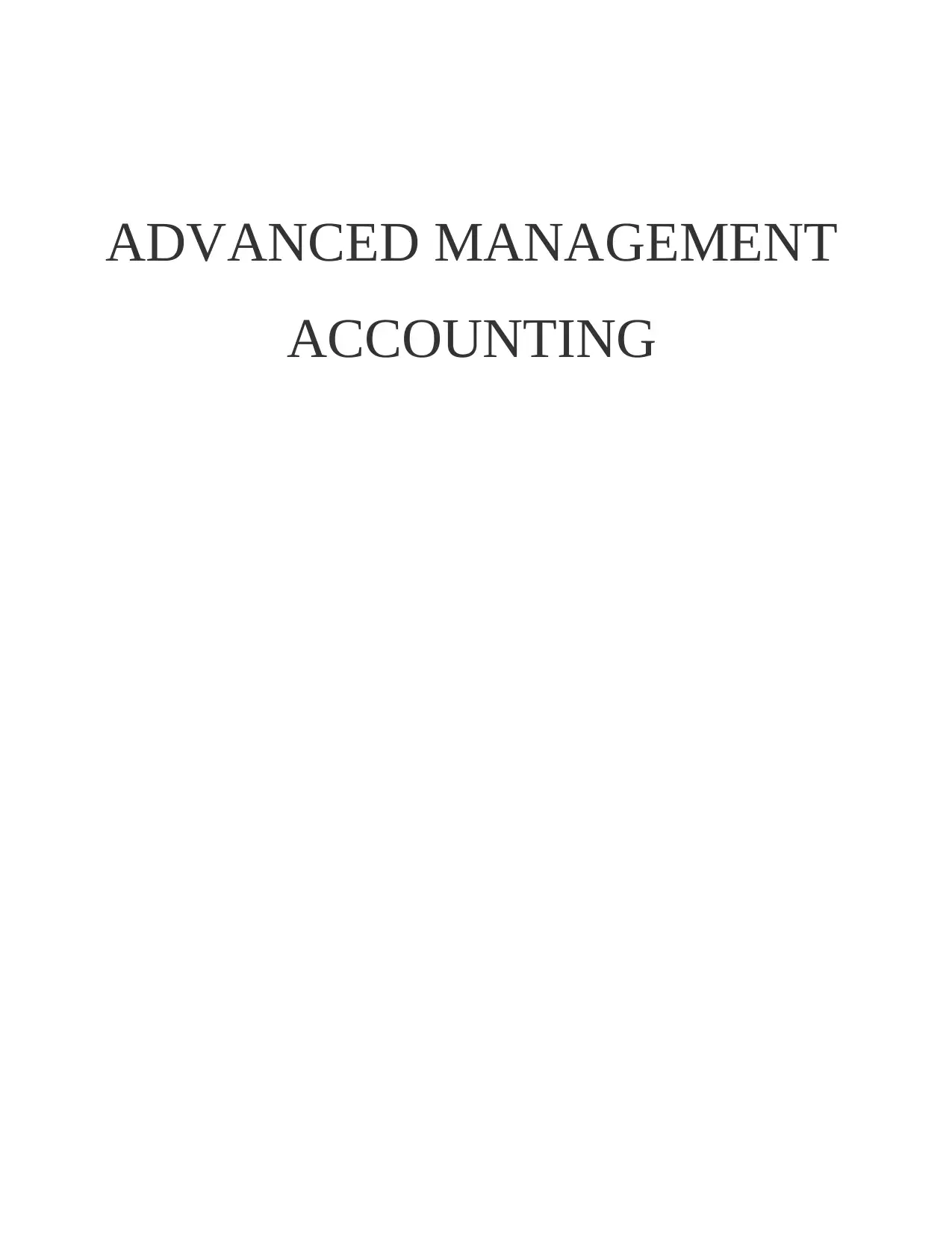
ADVANCED MANAGEMENT
ACCOUNTING
ACCOUNTING
Paraphrase This Document
Need a fresh take? Get an instant paraphrase of this document with our AI Paraphraser
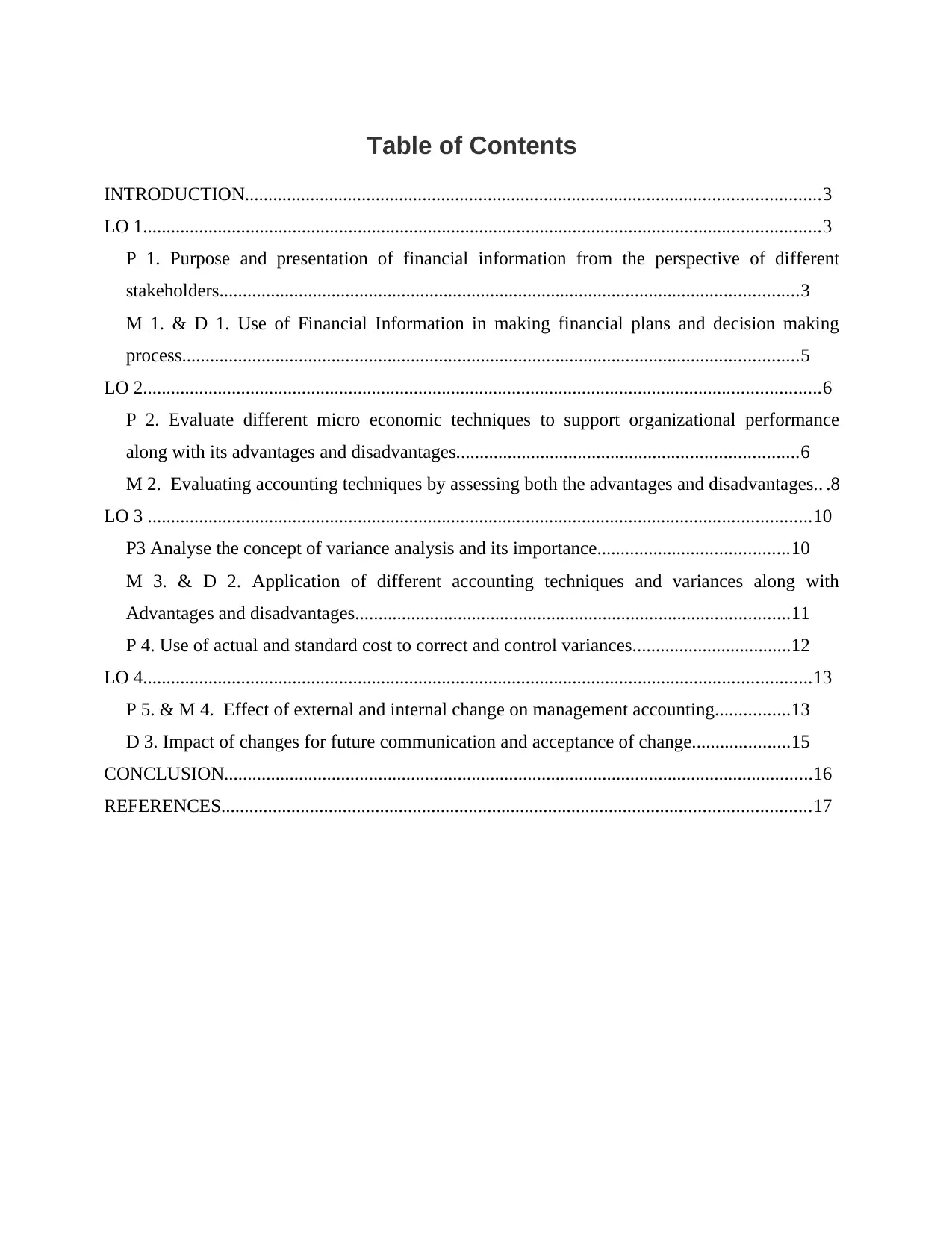
Table of Contents
INTRODUCTION...........................................................................................................................3
LO 1.................................................................................................................................................3
P 1. Purpose and presentation of financial information from the perspective of different
stakeholders............................................................................................................................3
M 1. & D 1. Use of Financial Information in making financial plans and decision making
process....................................................................................................................................5
LO 2.................................................................................................................................................6
P 2. Evaluate different micro economic techniques to support organizational performance
along with its advantages and disadvantages.........................................................................6
M 2. Evaluating accounting techniques by assessing both the advantages and disadvantages.. .8
LO 3 ..............................................................................................................................................10
P3 Analyse the concept of variance analysis and its importance.........................................10
M 3. & D 2. Application of different accounting techniques and variances along with
Advantages and disadvantages.............................................................................................11
P 4. Use of actual and standard cost to correct and control variances..................................12
LO 4...............................................................................................................................................13
P 5. & M 4. Effect of external and internal change on management accounting................13
D 3. Impact of changes for future communication and acceptance of change.....................15
CONCLUSION..............................................................................................................................16
REFERENCES..............................................................................................................................17
INTRODUCTION...........................................................................................................................3
LO 1.................................................................................................................................................3
P 1. Purpose and presentation of financial information from the perspective of different
stakeholders............................................................................................................................3
M 1. & D 1. Use of Financial Information in making financial plans and decision making
process....................................................................................................................................5
LO 2.................................................................................................................................................6
P 2. Evaluate different micro economic techniques to support organizational performance
along with its advantages and disadvantages.........................................................................6
M 2. Evaluating accounting techniques by assessing both the advantages and disadvantages.. .8
LO 3 ..............................................................................................................................................10
P3 Analyse the concept of variance analysis and its importance.........................................10
M 3. & D 2. Application of different accounting techniques and variances along with
Advantages and disadvantages.............................................................................................11
P 4. Use of actual and standard cost to correct and control variances..................................12
LO 4...............................................................................................................................................13
P 5. & M 4. Effect of external and internal change on management accounting................13
D 3. Impact of changes for future communication and acceptance of change.....................15
CONCLUSION..............................................................................................................................16
REFERENCES..............................................................................................................................17
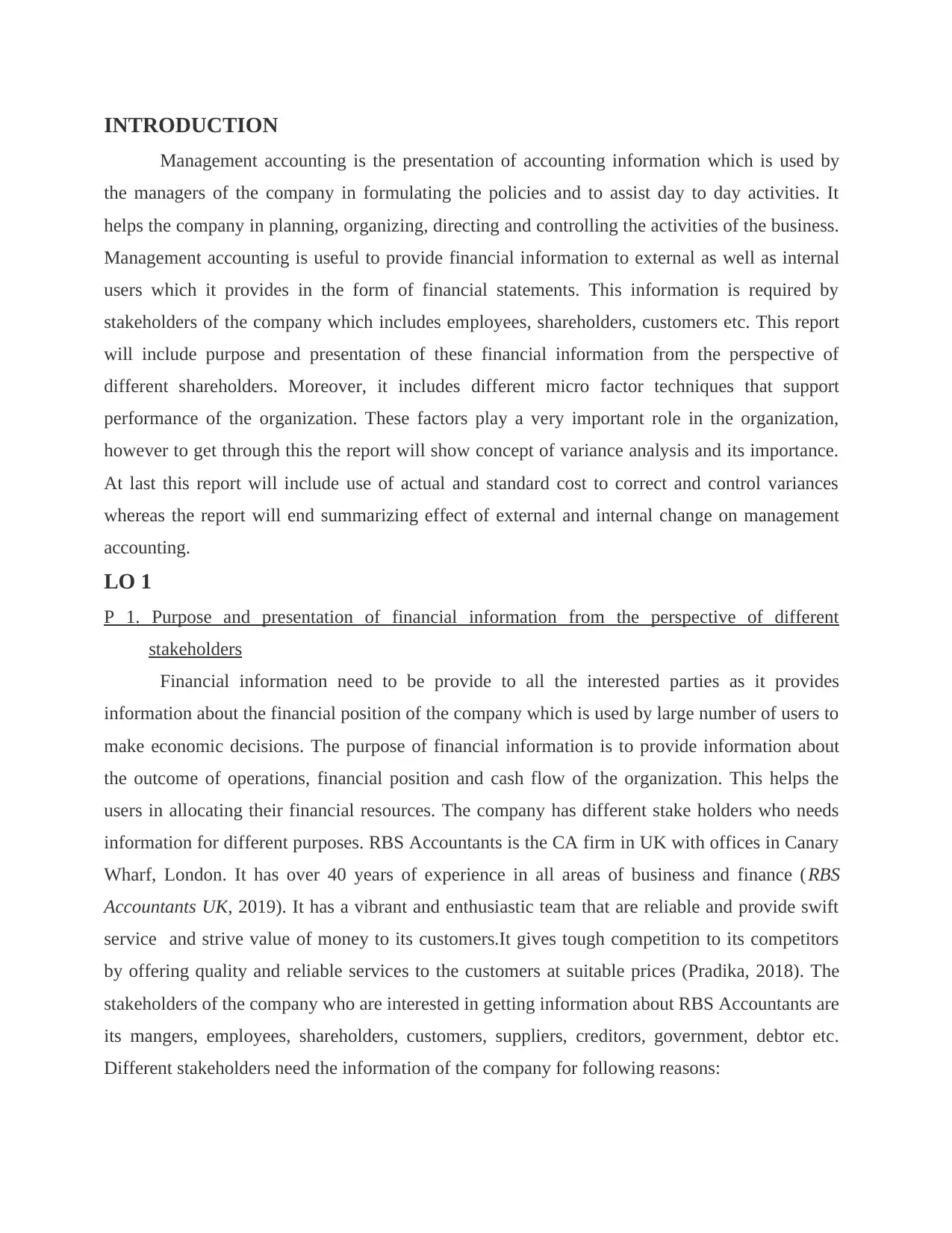
INTRODUCTION
Management accounting is the presentation of accounting information which is used by
the managers of the company in formulating the policies and to assist day to day activities. It
helps the company in planning, organizing, directing and controlling the activities of the business.
Management accounting is useful to provide financial information to external as well as internal
users which it provides in the form of financial statements. This information is required by
stakeholders of the company which includes employees, shareholders, customers etc. This report
will include purpose and presentation of these financial information from the perspective of
different shareholders. Moreover, it includes different micro factor techniques that support
performance of the organization. These factors play a very important role in the organization,
however to get through this the report will show concept of variance analysis and its importance.
At last this report will include use of actual and standard cost to correct and control variances
whereas the report will end summarizing effect of external and internal change on management
accounting.
LO 1
P 1. Purpose and presentation of financial information from the perspective of different
stakeholders
Financial information need to be provide to all the interested parties as it provides
information about the financial position of the company which is used by large number of users to
make economic decisions. The purpose of financial information is to provide information about
the outcome of operations, financial position and cash flow of the organization. This helps the
users in allocating their financial resources. The company has different stake holders who needs
information for different purposes. RBS Accountants is the CA firm in UK with offices in Canary
Wharf, London. It has over 40 years of experience in all areas of business and finance (RBS
Accountants UK, 2019). It has a vibrant and enthusiastic team that are reliable and provide swift
service and strive value of money to its customers.It gives tough competition to its competitors
by offering quality and reliable services to the customers at suitable prices (Pradika, 2018). The
stakeholders of the company who are interested in getting information about RBS Accountants are
its mangers, employees, shareholders, customers, suppliers, creditors, government, debtor etc.
Different stakeholders need the information of the company for following reasons:
Management accounting is the presentation of accounting information which is used by
the managers of the company in formulating the policies and to assist day to day activities. It
helps the company in planning, organizing, directing and controlling the activities of the business.
Management accounting is useful to provide financial information to external as well as internal
users which it provides in the form of financial statements. This information is required by
stakeholders of the company which includes employees, shareholders, customers etc. This report
will include purpose and presentation of these financial information from the perspective of
different shareholders. Moreover, it includes different micro factor techniques that support
performance of the organization. These factors play a very important role in the organization,
however to get through this the report will show concept of variance analysis and its importance.
At last this report will include use of actual and standard cost to correct and control variances
whereas the report will end summarizing effect of external and internal change on management
accounting.
LO 1
P 1. Purpose and presentation of financial information from the perspective of different
stakeholders
Financial information need to be provide to all the interested parties as it provides
information about the financial position of the company which is used by large number of users to
make economic decisions. The purpose of financial information is to provide information about
the outcome of operations, financial position and cash flow of the organization. This helps the
users in allocating their financial resources. The company has different stake holders who needs
information for different purposes. RBS Accountants is the CA firm in UK with offices in Canary
Wharf, London. It has over 40 years of experience in all areas of business and finance (RBS
Accountants UK, 2019). It has a vibrant and enthusiastic team that are reliable and provide swift
service and strive value of money to its customers.It gives tough competition to its competitors
by offering quality and reliable services to the customers at suitable prices (Pradika, 2018). The
stakeholders of the company who are interested in getting information about RBS Accountants are
its mangers, employees, shareholders, customers, suppliers, creditors, government, debtor etc.
Different stakeholders need the information of the company for following reasons:
⊘ This is a preview!⊘
Do you want full access?
Subscribe today to unlock all pages.

Trusted by 1+ million students worldwide
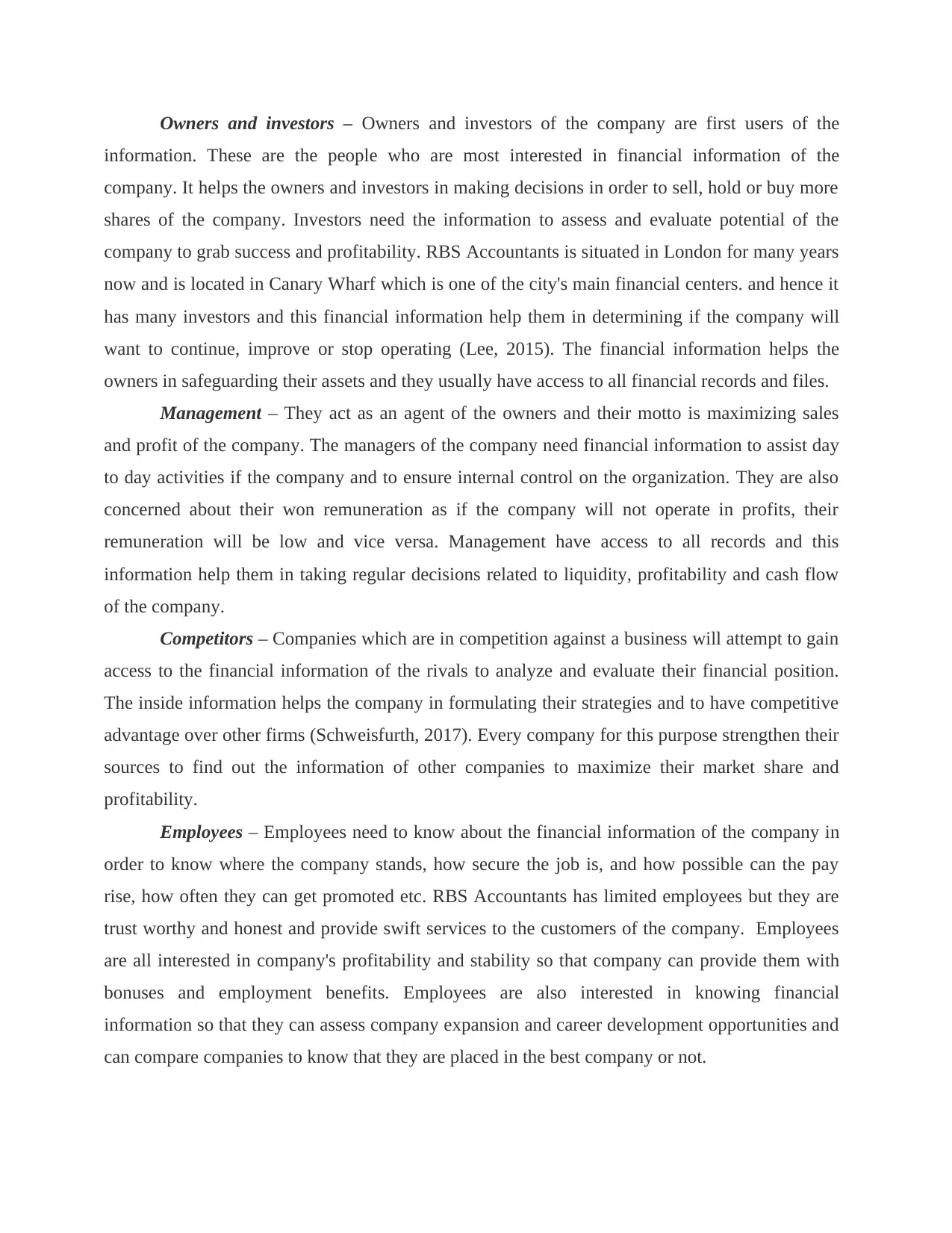
Owners and investors – Owners and investors of the company are first users of the
information. These are the people who are most interested in financial information of the
company. It helps the owners and investors in making decisions in order to sell, hold or buy more
shares of the company. Investors need the information to assess and evaluate potential of the
company to grab success and profitability. RBS Accountants is situated in London for many years
now and is located in Canary Wharf which is one of the city's main financial centers. and hence it
has many investors and this financial information help them in determining if the company will
want to continue, improve or stop operating (Lee, 2015). The financial information helps the
owners in safeguarding their assets and they usually have access to all financial records and files.
Management – They act as an agent of the owners and their motto is maximizing sales
and profit of the company. The managers of the company need financial information to assist day
to day activities if the company and to ensure internal control on the organization. They are also
concerned about their won remuneration as if the company will not operate in profits, their
remuneration will be low and vice versa. Management have access to all records and this
information help them in taking regular decisions related to liquidity, profitability and cash flow
of the company.
Competitors – Companies which are in competition against a business will attempt to gain
access to the financial information of the rivals to analyze and evaluate their financial position.
The inside information helps the company in formulating their strategies and to have competitive
advantage over other firms (Schweisfurth, 2017). Every company for this purpose strengthen their
sources to find out the information of other companies to maximize their market share and
profitability.
Employees – Employees need to know about the financial information of the company in
order to know where the company stands, how secure the job is, and how possible can the pay
rise, how often they can get promoted etc. RBS Accountants has limited employees but they are
trust worthy and honest and provide swift services to the customers of the company. Employees
are all interested in company's profitability and stability so that company can provide them with
bonuses and employment benefits. Employees are also interested in knowing financial
information so that they can assess company expansion and career development opportunities and
can compare companies to know that they are placed in the best company or not.
information. These are the people who are most interested in financial information of the
company. It helps the owners and investors in making decisions in order to sell, hold or buy more
shares of the company. Investors need the information to assess and evaluate potential of the
company to grab success and profitability. RBS Accountants is situated in London for many years
now and is located in Canary Wharf which is one of the city's main financial centers. and hence it
has many investors and this financial information help them in determining if the company will
want to continue, improve or stop operating (Lee, 2015). The financial information helps the
owners in safeguarding their assets and they usually have access to all financial records and files.
Management – They act as an agent of the owners and their motto is maximizing sales
and profit of the company. The managers of the company need financial information to assist day
to day activities if the company and to ensure internal control on the organization. They are also
concerned about their won remuneration as if the company will not operate in profits, their
remuneration will be low and vice versa. Management have access to all records and this
information help them in taking regular decisions related to liquidity, profitability and cash flow
of the company.
Competitors – Companies which are in competition against a business will attempt to gain
access to the financial information of the rivals to analyze and evaluate their financial position.
The inside information helps the company in formulating their strategies and to have competitive
advantage over other firms (Schweisfurth, 2017). Every company for this purpose strengthen their
sources to find out the information of other companies to maximize their market share and
profitability.
Employees – Employees need to know about the financial information of the company in
order to know where the company stands, how secure the job is, and how possible can the pay
rise, how often they can get promoted etc. RBS Accountants has limited employees but they are
trust worthy and honest and provide swift services to the customers of the company. Employees
are all interested in company's profitability and stability so that company can provide them with
bonuses and employment benefits. Employees are also interested in knowing financial
information so that they can assess company expansion and career development opportunities and
can compare companies to know that they are placed in the best company or not.
Paraphrase This Document
Need a fresh take? Get an instant paraphrase of this document with our AI Paraphraser
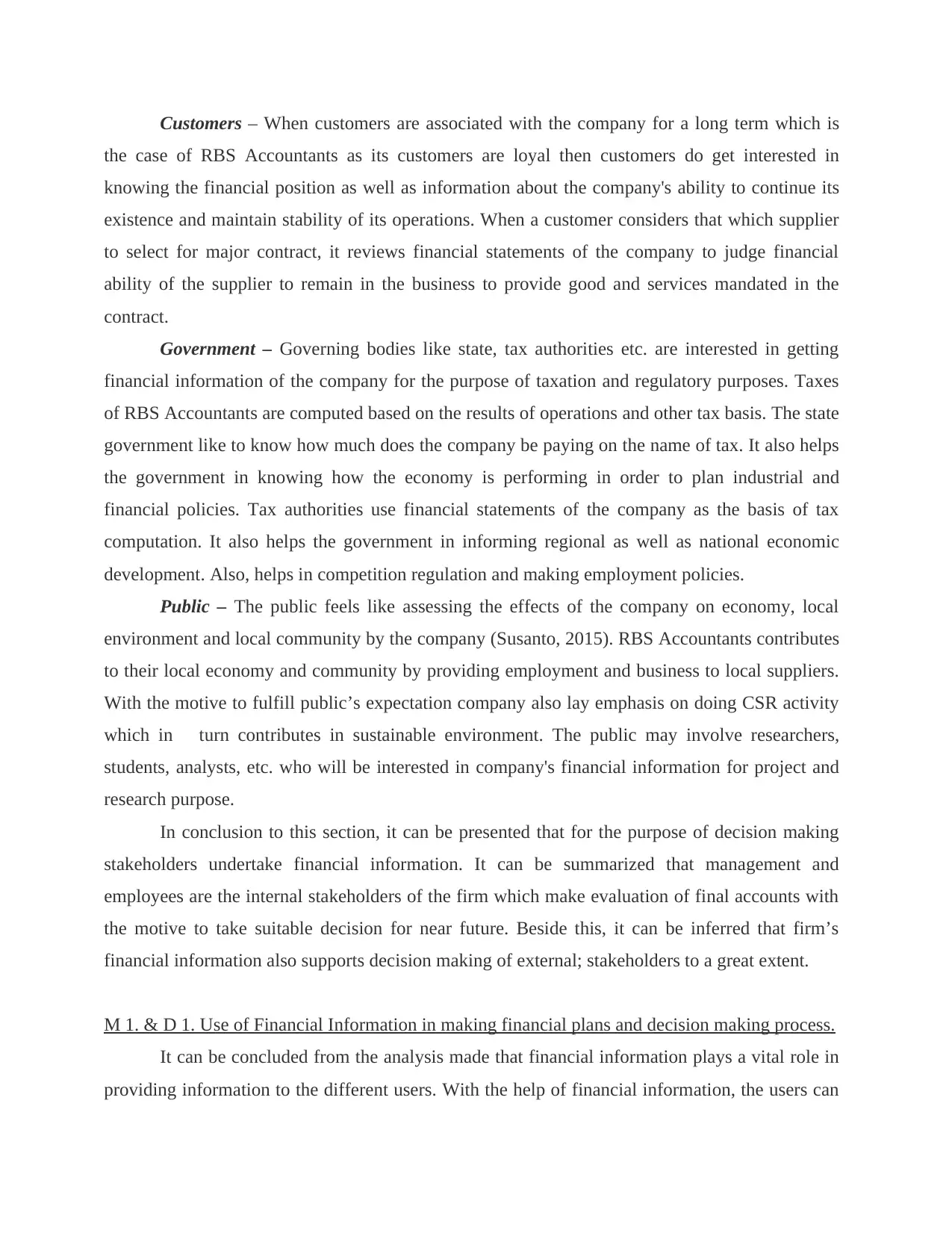
Customers – When customers are associated with the company for a long term which is
the case of RBS Accountants as its customers are loyal then customers do get interested in
knowing the financial position as well as information about the company's ability to continue its
existence and maintain stability of its operations. When a customer considers that which supplier
to select for major contract, it reviews financial statements of the company to judge financial
ability of the supplier to remain in the business to provide good and services mandated in the
contract.
Government – Governing bodies like state, tax authorities etc. are interested in getting
financial information of the company for the purpose of taxation and regulatory purposes. Taxes
of RBS Accountants are computed based on the results of operations and other tax basis. The state
government like to know how much does the company be paying on the name of tax. It also helps
the government in knowing how the economy is performing in order to plan industrial and
financial policies. Tax authorities use financial statements of the company as the basis of tax
computation. It also helps the government in informing regional as well as national economic
development. Also, helps in competition regulation and making employment policies.
Public – The public feels like assessing the effects of the company on economy, local
environment and local community by the company (Susanto, 2015). RBS Accountants contributes
to their local economy and community by providing employment and business to local suppliers.
With the motive to fulfill public’s expectation company also lay emphasis on doing CSR activity
which in turn contributes in sustainable environment. The public may involve researchers,
students, analysts, etc. who will be interested in company's financial information for project and
research purpose.
In conclusion to this section, it can be presented that for the purpose of decision making
stakeholders undertake financial information. It can be summarized that management and
employees are the internal stakeholders of the firm which make evaluation of final accounts with
the motive to take suitable decision for near future. Beside this, it can be inferred that firm’s
financial information also supports decision making of external; stakeholders to a great extent.
M 1. & D 1. Use of Financial Information in making financial plans and decision making process.
It can be concluded from the analysis made that financial information plays a vital role in
providing information to the different users. With the help of financial information, the users can
the case of RBS Accountants as its customers are loyal then customers do get interested in
knowing the financial position as well as information about the company's ability to continue its
existence and maintain stability of its operations. When a customer considers that which supplier
to select for major contract, it reviews financial statements of the company to judge financial
ability of the supplier to remain in the business to provide good and services mandated in the
contract.
Government – Governing bodies like state, tax authorities etc. are interested in getting
financial information of the company for the purpose of taxation and regulatory purposes. Taxes
of RBS Accountants are computed based on the results of operations and other tax basis. The state
government like to know how much does the company be paying on the name of tax. It also helps
the government in knowing how the economy is performing in order to plan industrial and
financial policies. Tax authorities use financial statements of the company as the basis of tax
computation. It also helps the government in informing regional as well as national economic
development. Also, helps in competition regulation and making employment policies.
Public – The public feels like assessing the effects of the company on economy, local
environment and local community by the company (Susanto, 2015). RBS Accountants contributes
to their local economy and community by providing employment and business to local suppliers.
With the motive to fulfill public’s expectation company also lay emphasis on doing CSR activity
which in turn contributes in sustainable environment. The public may involve researchers,
students, analysts, etc. who will be interested in company's financial information for project and
research purpose.
In conclusion to this section, it can be presented that for the purpose of decision making
stakeholders undertake financial information. It can be summarized that management and
employees are the internal stakeholders of the firm which make evaluation of final accounts with
the motive to take suitable decision for near future. Beside this, it can be inferred that firm’s
financial information also supports decision making of external; stakeholders to a great extent.
M 1. & D 1. Use of Financial Information in making financial plans and decision making process.
It can be concluded from the analysis made that financial information plays a vital role in
providing information to the different users. With the help of financial information, the users can
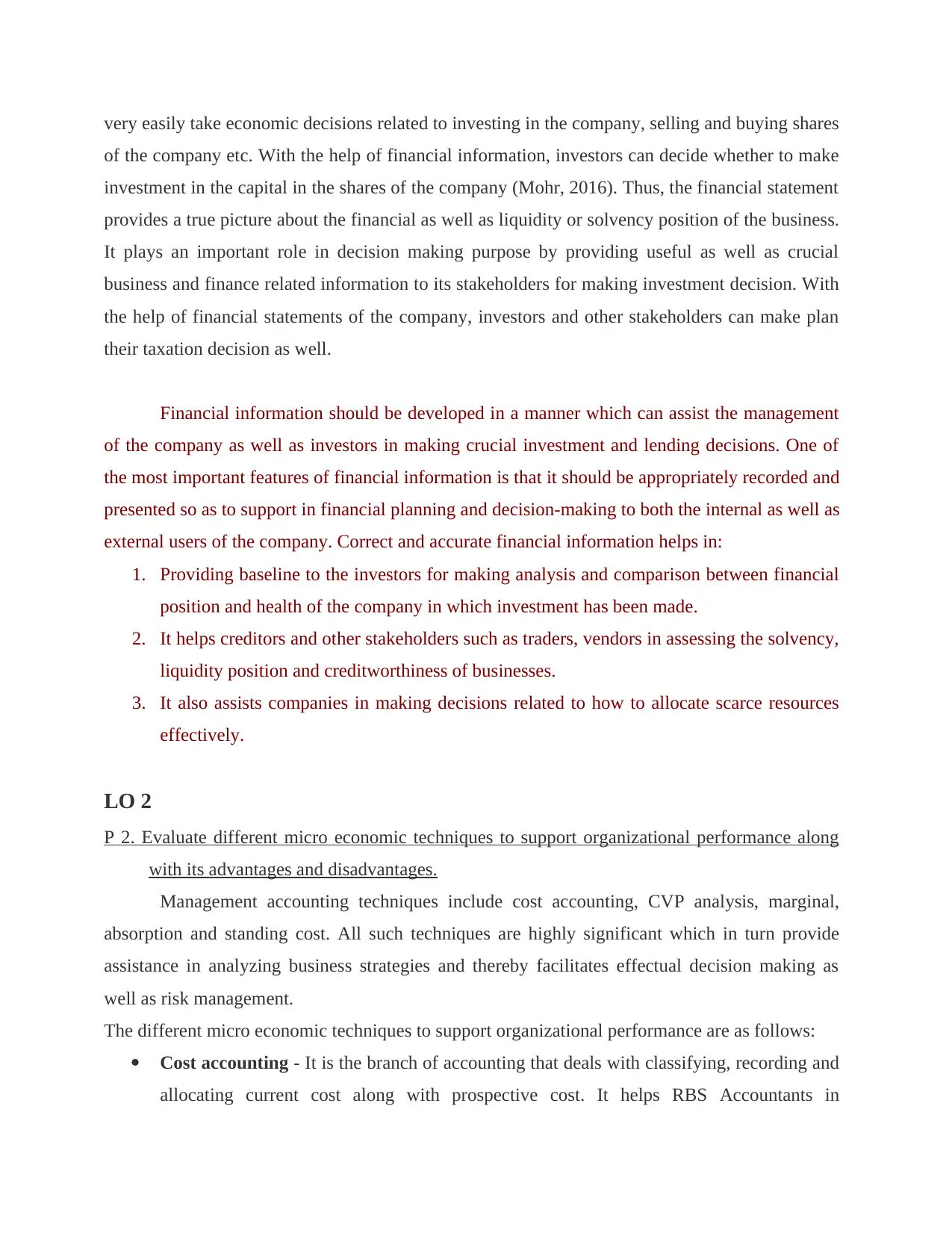
very easily take economic decisions related to investing in the company, selling and buying shares
of the company etc. With the help of financial information, investors can decide whether to make
investment in the capital in the shares of the company (Mohr, 2016). Thus, the financial statement
provides a true picture about the financial as well as liquidity or solvency position of the business.
It plays an important role in decision making purpose by providing useful as well as crucial
business and finance related information to its stakeholders for making investment decision. With
the help of financial statements of the company, investors and other stakeholders can make plan
their taxation decision as well.
Financial information should be developed in a manner which can assist the management
of the company as well as investors in making crucial investment and lending decisions. One of
the most important features of financial information is that it should be appropriately recorded and
presented so as to support in financial planning and decision-making to both the internal as well as
external users of the company. Correct and accurate financial information helps in:
1. Providing baseline to the investors for making analysis and comparison between financial
position and health of the company in which investment has been made.
2. It helps creditors and other stakeholders such as traders, vendors in assessing the solvency,
liquidity position and creditworthiness of businesses.
3. It also assists companies in making decisions related to how to allocate scarce resources
effectively.
LO 2
P 2. Evaluate different micro economic techniques to support organizational performance along
with its advantages and disadvantages.
Management accounting techniques include cost accounting, CVP analysis, marginal,
absorption and standing cost. All such techniques are highly significant which in turn provide
assistance in analyzing business strategies and thereby facilitates effectual decision making as
well as risk management.
The different micro economic techniques to support organizational performance are as follows:
Cost accounting - It is the branch of accounting that deals with classifying, recording and
allocating current cost along with prospective cost. It helps RBS Accountants in
of the company etc. With the help of financial information, investors can decide whether to make
investment in the capital in the shares of the company (Mohr, 2016). Thus, the financial statement
provides a true picture about the financial as well as liquidity or solvency position of the business.
It plays an important role in decision making purpose by providing useful as well as crucial
business and finance related information to its stakeholders for making investment decision. With
the help of financial statements of the company, investors and other stakeholders can make plan
their taxation decision as well.
Financial information should be developed in a manner which can assist the management
of the company as well as investors in making crucial investment and lending decisions. One of
the most important features of financial information is that it should be appropriately recorded and
presented so as to support in financial planning and decision-making to both the internal as well as
external users of the company. Correct and accurate financial information helps in:
1. Providing baseline to the investors for making analysis and comparison between financial
position and health of the company in which investment has been made.
2. It helps creditors and other stakeholders such as traders, vendors in assessing the solvency,
liquidity position and creditworthiness of businesses.
3. It also assists companies in making decisions related to how to allocate scarce resources
effectively.
LO 2
P 2. Evaluate different micro economic techniques to support organizational performance along
with its advantages and disadvantages.
Management accounting techniques include cost accounting, CVP analysis, marginal,
absorption and standing cost. All such techniques are highly significant which in turn provide
assistance in analyzing business strategies and thereby facilitates effectual decision making as
well as risk management.
The different micro economic techniques to support organizational performance are as follows:
Cost accounting - It is the branch of accounting that deals with classifying, recording and
allocating current cost along with prospective cost. It helps RBS Accountants in
⊘ This is a preview!⊘
Do you want full access?
Subscribe today to unlock all pages.

Trusted by 1+ million students worldwide
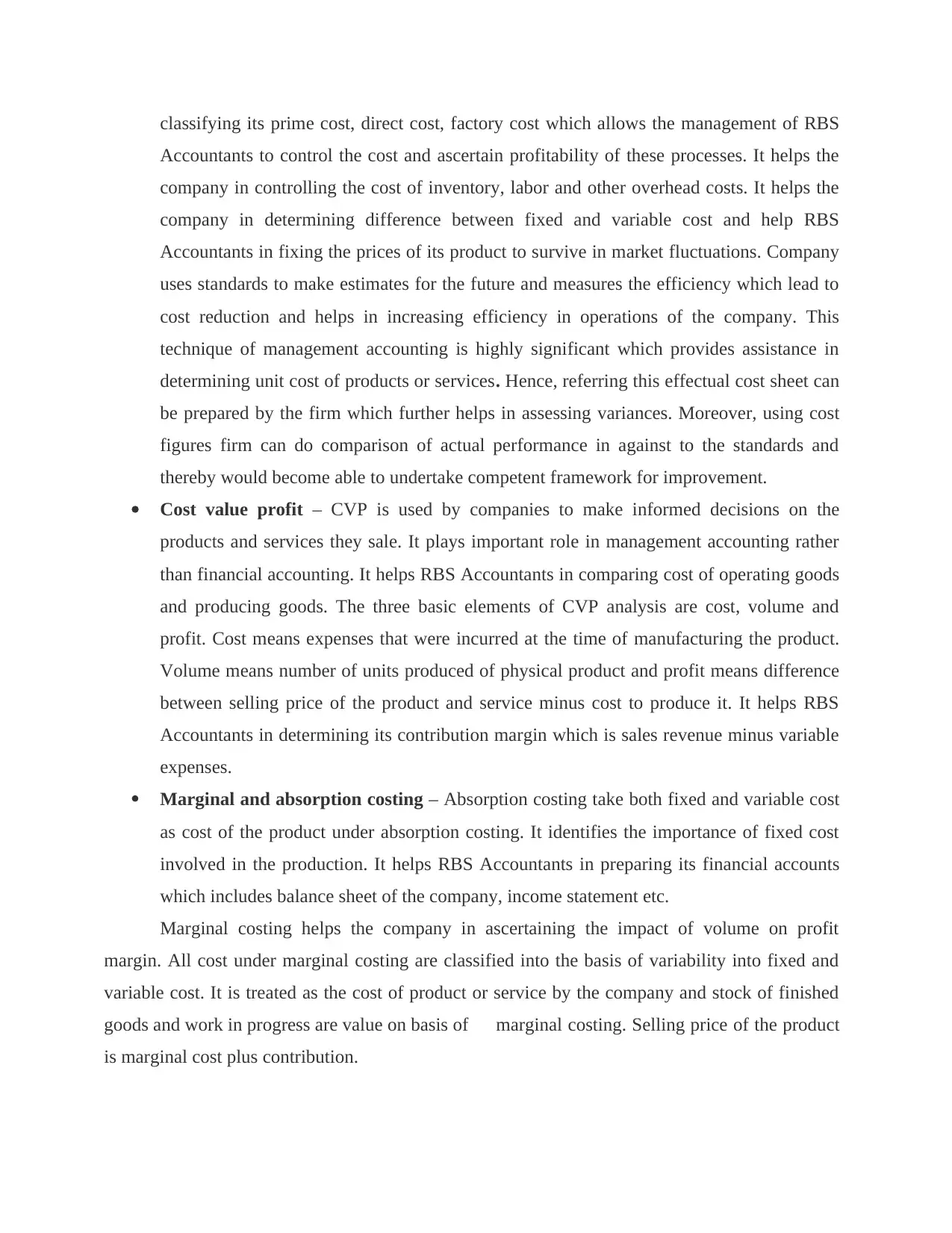
classifying its prime cost, direct cost, factory cost which allows the management of RBS
Accountants to control the cost and ascertain profitability of these processes. It helps the
company in controlling the cost of inventory, labor and other overhead costs. It helps the
company in determining difference between fixed and variable cost and help RBS
Accountants in fixing the prices of its product to survive in market fluctuations. Company
uses standards to make estimates for the future and measures the efficiency which lead to
cost reduction and helps in increasing efficiency in operations of the company. This
technique of management accounting is highly significant which provides assistance in
determining unit cost of products or services. Hence, referring this effectual cost sheet can
be prepared by the firm which further helps in assessing variances. Moreover, using cost
figures firm can do comparison of actual performance in against to the standards and
thereby would become able to undertake competent framework for improvement.
Cost value profit – CVP is used by companies to make informed decisions on the
products and services they sale. It plays important role in management accounting rather
than financial accounting. It helps RBS Accountants in comparing cost of operating goods
and producing goods. The three basic elements of CVP analysis are cost, volume and
profit. Cost means expenses that were incurred at the time of manufacturing the product.
Volume means number of units produced of physical product and profit means difference
between selling price of the product and service minus cost to produce it. It helps RBS
Accountants in determining its contribution margin which is sales revenue minus variable
expenses.
Marginal and absorption costing – Absorption costing take both fixed and variable cost
as cost of the product under absorption costing. It identifies the importance of fixed cost
involved in the production. It helps RBS Accountants in preparing its financial accounts
which includes balance sheet of the company, income statement etc.
Marginal costing helps the company in ascertaining the impact of volume on profit
margin. All cost under marginal costing are classified into the basis of variability into fixed and
variable cost. It is treated as the cost of product or service by the company and stock of finished
goods and work in progress are value on basis of marginal costing. Selling price of the product
is marginal cost plus contribution.
Accountants to control the cost and ascertain profitability of these processes. It helps the
company in controlling the cost of inventory, labor and other overhead costs. It helps the
company in determining difference between fixed and variable cost and help RBS
Accountants in fixing the prices of its product to survive in market fluctuations. Company
uses standards to make estimates for the future and measures the efficiency which lead to
cost reduction and helps in increasing efficiency in operations of the company. This
technique of management accounting is highly significant which provides assistance in
determining unit cost of products or services. Hence, referring this effectual cost sheet can
be prepared by the firm which further helps in assessing variances. Moreover, using cost
figures firm can do comparison of actual performance in against to the standards and
thereby would become able to undertake competent framework for improvement.
Cost value profit – CVP is used by companies to make informed decisions on the
products and services they sale. It plays important role in management accounting rather
than financial accounting. It helps RBS Accountants in comparing cost of operating goods
and producing goods. The three basic elements of CVP analysis are cost, volume and
profit. Cost means expenses that were incurred at the time of manufacturing the product.
Volume means number of units produced of physical product and profit means difference
between selling price of the product and service minus cost to produce it. It helps RBS
Accountants in determining its contribution margin which is sales revenue minus variable
expenses.
Marginal and absorption costing – Absorption costing take both fixed and variable cost
as cost of the product under absorption costing. It identifies the importance of fixed cost
involved in the production. It helps RBS Accountants in preparing its financial accounts
which includes balance sheet of the company, income statement etc.
Marginal costing helps the company in ascertaining the impact of volume on profit
margin. All cost under marginal costing are classified into the basis of variability into fixed and
variable cost. It is treated as the cost of product or service by the company and stock of finished
goods and work in progress are value on basis of marginal costing. Selling price of the product
is marginal cost plus contribution.
Paraphrase This Document
Need a fresh take? Get an instant paraphrase of this document with our AI Paraphraser
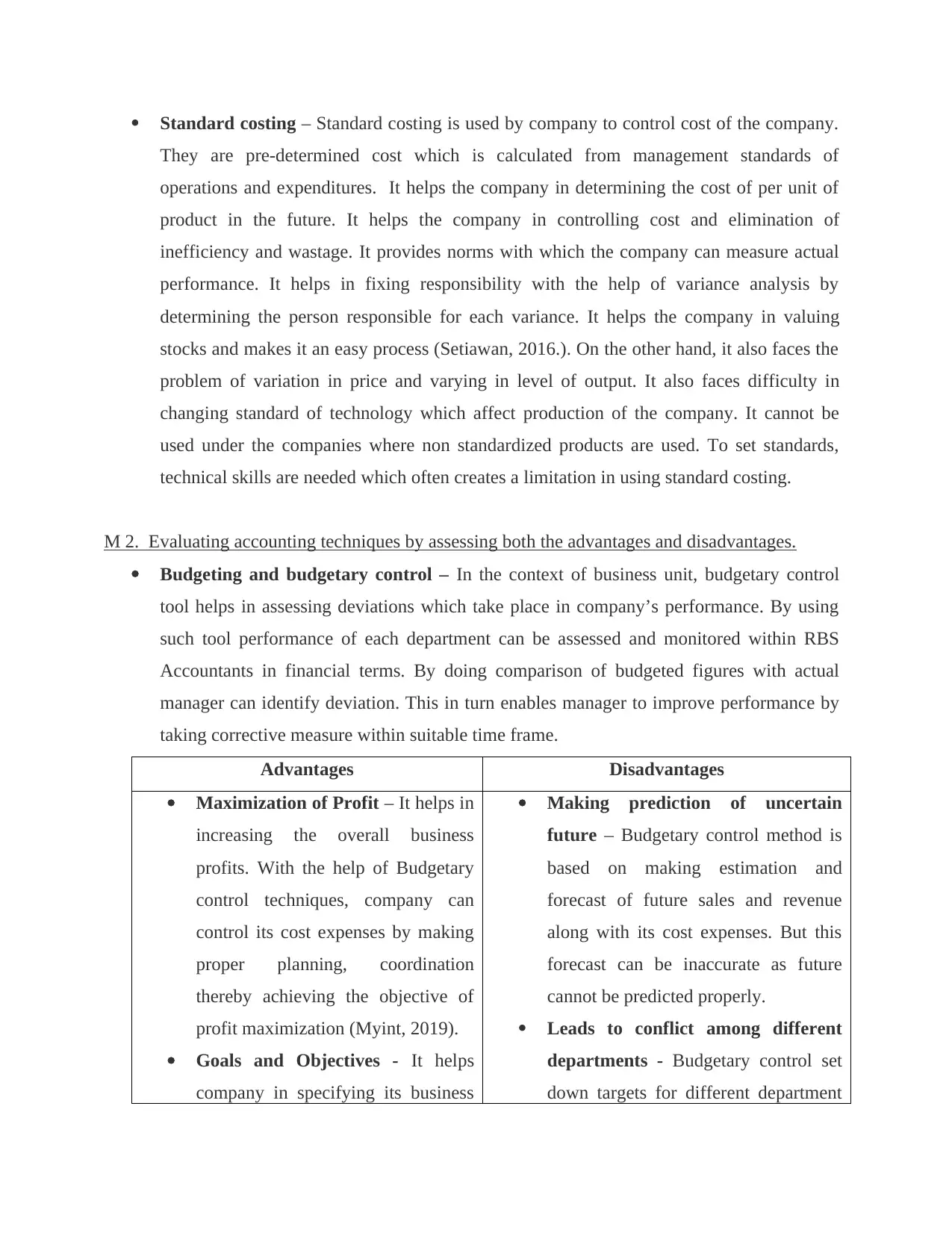
Standard costing – Standard costing is used by company to control cost of the company.
They are pre-determined cost which is calculated from management standards of
operations and expenditures. It helps the company in determining the cost of per unit of
product in the future. It helps the company in controlling cost and elimination of
inefficiency and wastage. It provides norms with which the company can measure actual
performance. It helps in fixing responsibility with the help of variance analysis by
determining the person responsible for each variance. It helps the company in valuing
stocks and makes it an easy process (Setiawan, 2016.). On the other hand, it also faces the
problem of variation in price and varying in level of output. It also faces difficulty in
changing standard of technology which affect production of the company. It cannot be
used under the companies where non standardized products are used. To set standards,
technical skills are needed which often creates a limitation in using standard costing.
M 2. Evaluating accounting techniques by assessing both the advantages and disadvantages.
Budgeting and budgetary control – In the context of business unit, budgetary control
tool helps in assessing deviations which take place in company’s performance. By using
such tool performance of each department can be assessed and monitored within RBS
Accountants in financial terms. By doing comparison of budgeted figures with actual
manager can identify deviation. This in turn enables manager to improve performance by
taking corrective measure within suitable time frame.
Advantages Disadvantages
Maximization of Profit – It helps in
increasing the overall business
profits. With the help of Budgetary
control techniques, company can
control its cost expenses by making
proper planning, coordination
thereby achieving the objective of
profit maximization (Myint, 2019).
Goals and Objectives - It helps
company in specifying its business
Making prediction of uncertain
future – Budgetary control method is
based on making estimation and
forecast of future sales and revenue
along with its cost expenses. But this
forecast can be inaccurate as future
cannot be predicted properly.
Leads to conflict among different
departments - Budgetary control set
down targets for different department
They are pre-determined cost which is calculated from management standards of
operations and expenditures. It helps the company in determining the cost of per unit of
product in the future. It helps the company in controlling cost and elimination of
inefficiency and wastage. It provides norms with which the company can measure actual
performance. It helps in fixing responsibility with the help of variance analysis by
determining the person responsible for each variance. It helps the company in valuing
stocks and makes it an easy process (Setiawan, 2016.). On the other hand, it also faces the
problem of variation in price and varying in level of output. It also faces difficulty in
changing standard of technology which affect production of the company. It cannot be
used under the companies where non standardized products are used. To set standards,
technical skills are needed which often creates a limitation in using standard costing.
M 2. Evaluating accounting techniques by assessing both the advantages and disadvantages.
Budgeting and budgetary control – In the context of business unit, budgetary control
tool helps in assessing deviations which take place in company’s performance. By using
such tool performance of each department can be assessed and monitored within RBS
Accountants in financial terms. By doing comparison of budgeted figures with actual
manager can identify deviation. This in turn enables manager to improve performance by
taking corrective measure within suitable time frame.
Advantages Disadvantages
Maximization of Profit – It helps in
increasing the overall business
profits. With the help of Budgetary
control techniques, company can
control its cost expenses by making
proper planning, coordination
thereby achieving the objective of
profit maximization (Myint, 2019).
Goals and Objectives - It helps
company in specifying its business
Making prediction of uncertain
future – Budgetary control method is
based on making estimation and
forecast of future sales and revenue
along with its cost expenses. But this
forecast can be inaccurate as future
cannot be predicted properly.
Leads to conflict among different
departments - Budgetary control set
down targets for different department
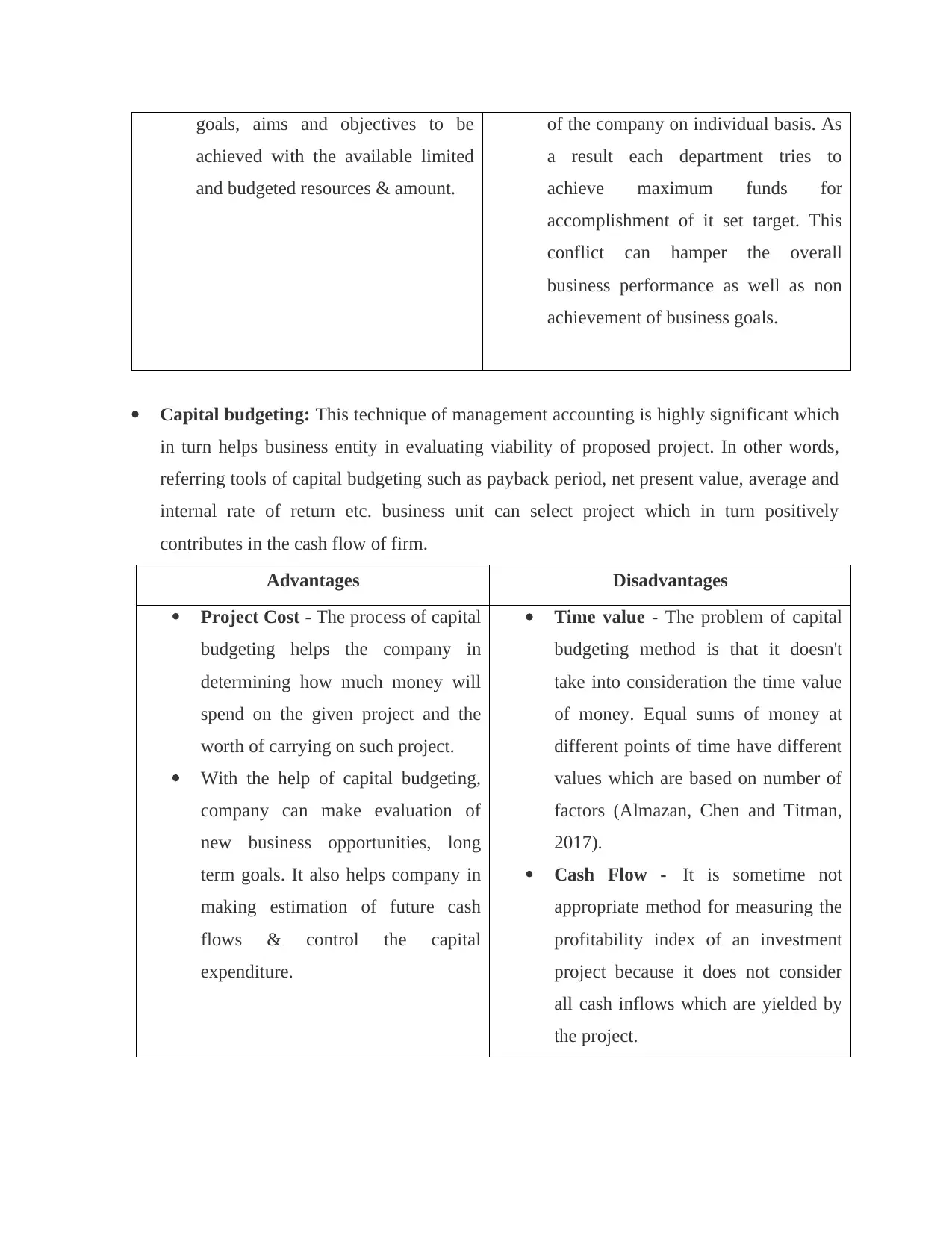
goals, aims and objectives to be
achieved with the available limited
and budgeted resources & amount.
of the company on individual basis. As
a result each department tries to
achieve maximum funds for
accomplishment of it set target. This
conflict can hamper the overall
business performance as well as non
achievement of business goals.
Capital budgeting: This technique of management accounting is highly significant which
in turn helps business entity in evaluating viability of proposed project. In other words,
referring tools of capital budgeting such as payback period, net present value, average and
internal rate of return etc. business unit can select project which in turn positively
contributes in the cash flow of firm.
Advantages Disadvantages
Project Cost - The process of capital
budgeting helps the company in
determining how much money will
spend on the given project and the
worth of carrying on such project.
With the help of capital budgeting,
company can make evaluation of
new business opportunities, long
term goals. It also helps company in
making estimation of future cash
flows & control the capital
expenditure.
Time value - The problem of capital
budgeting method is that it doesn't
take into consideration the time value
of money. Equal sums of money at
different points of time have different
values which are based on number of
factors (Almazan, Chen and Titman,
2017).
Cash Flow - It is sometime not
appropriate method for measuring the
profitability index of an investment
project because it does not consider
all cash inflows which are yielded by
the project.
achieved with the available limited
and budgeted resources & amount.
of the company on individual basis. As
a result each department tries to
achieve maximum funds for
accomplishment of it set target. This
conflict can hamper the overall
business performance as well as non
achievement of business goals.
Capital budgeting: This technique of management accounting is highly significant which
in turn helps business entity in evaluating viability of proposed project. In other words,
referring tools of capital budgeting such as payback period, net present value, average and
internal rate of return etc. business unit can select project which in turn positively
contributes in the cash flow of firm.
Advantages Disadvantages
Project Cost - The process of capital
budgeting helps the company in
determining how much money will
spend on the given project and the
worth of carrying on such project.
With the help of capital budgeting,
company can make evaluation of
new business opportunities, long
term goals. It also helps company in
making estimation of future cash
flows & control the capital
expenditure.
Time value - The problem of capital
budgeting method is that it doesn't
take into consideration the time value
of money. Equal sums of money at
different points of time have different
values which are based on number of
factors (Almazan, Chen and Titman,
2017).
Cash Flow - It is sometime not
appropriate method for measuring the
profitability index of an investment
project because it does not consider
all cash inflows which are yielded by
the project.
⊘ This is a preview!⊘
Do you want full access?
Subscribe today to unlock all pages.

Trusted by 1+ million students worldwide
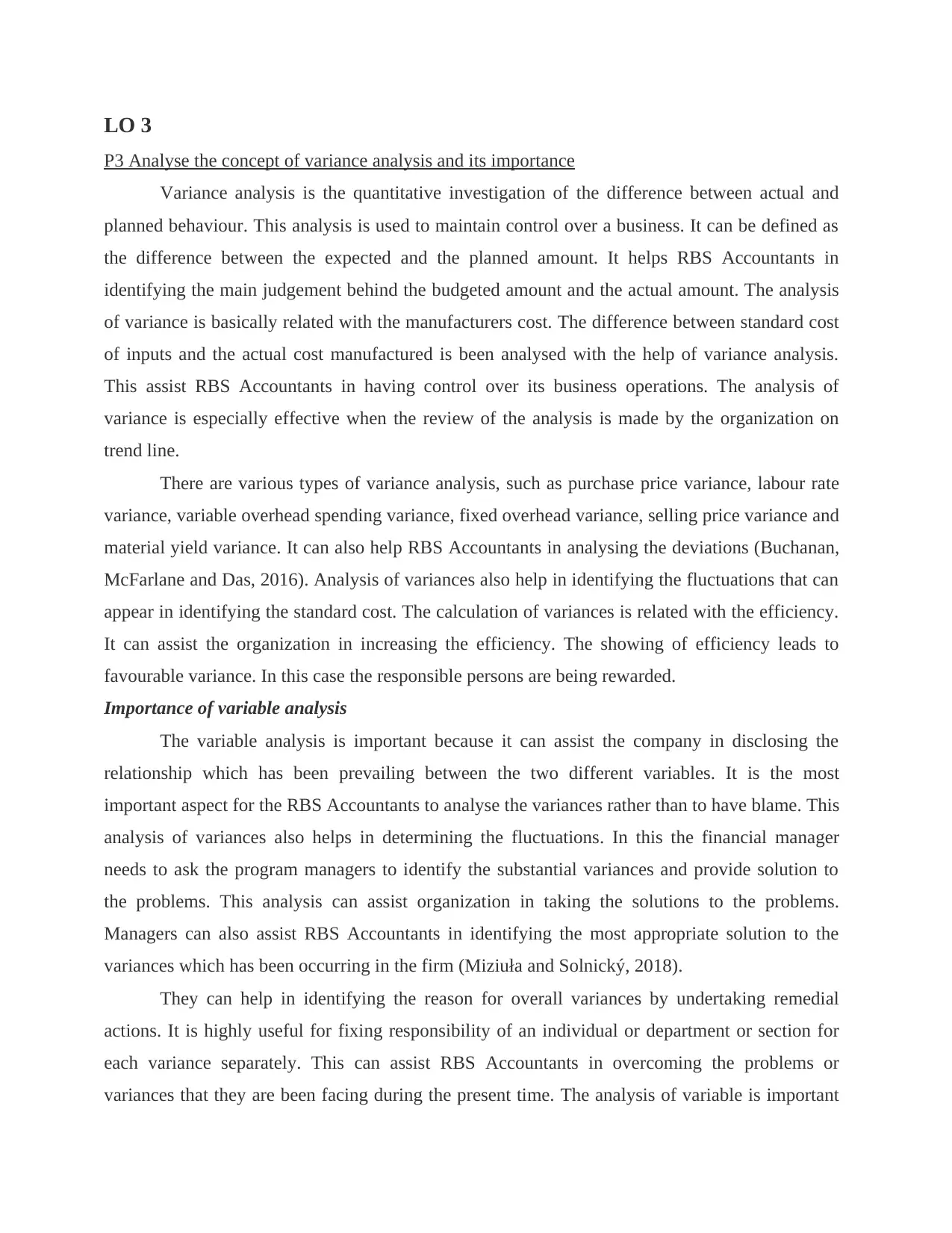
LO 3
P3 Analyse the concept of variance analysis and its importance
Variance analysis is the quantitative investigation of the difference between actual and
planned behaviour. This analysis is used to maintain control over a business. It can be defined as
the difference between the expected and the planned amount. It helps RBS Accountants in
identifying the main judgement behind the budgeted amount and the actual amount. The analysis
of variance is basically related with the manufacturers cost. The difference between standard cost
of inputs and the actual cost manufactured is been analysed with the help of variance analysis.
This assist RBS Accountants in having control over its business operations. The analysis of
variance is especially effective when the review of the analysis is made by the organization on
trend line.
There are various types of variance analysis, such as purchase price variance, labour rate
variance, variable overhead spending variance, fixed overhead variance, selling price variance and
material yield variance. It can also help RBS Accountants in analysing the deviations (Buchanan,
McFarlane and Das, 2016). Analysis of variances also help in identifying the fluctuations that can
appear in identifying the standard cost. The calculation of variances is related with the efficiency.
It can assist the organization in increasing the efficiency. The showing of efficiency leads to
favourable variance. In this case the responsible persons are being rewarded.
Importance of variable analysis
The variable analysis is important because it can assist the company in disclosing the
relationship which has been prevailing between the two different variables. It is the most
important aspect for the RBS Accountants to analyse the variances rather than to have blame. This
analysis of variances also helps in determining the fluctuations. In this the financial manager
needs to ask the program managers to identify the substantial variances and provide solution to
the problems. This analysis can assist organization in taking the solutions to the problems.
Managers can also assist RBS Accountants in identifying the most appropriate solution to the
variances which has been occurring in the firm (Miziuła and Solnický, 2018).
They can help in identifying the reason for overall variances by undertaking remedial
actions. It is highly useful for fixing responsibility of an individual or department or section for
each variance separately. This can assist RBS Accountants in overcoming the problems or
variances that they are been facing during the present time. The analysis of variable is important
P3 Analyse the concept of variance analysis and its importance
Variance analysis is the quantitative investigation of the difference between actual and
planned behaviour. This analysis is used to maintain control over a business. It can be defined as
the difference between the expected and the planned amount. It helps RBS Accountants in
identifying the main judgement behind the budgeted amount and the actual amount. The analysis
of variance is basically related with the manufacturers cost. The difference between standard cost
of inputs and the actual cost manufactured is been analysed with the help of variance analysis.
This assist RBS Accountants in having control over its business operations. The analysis of
variance is especially effective when the review of the analysis is made by the organization on
trend line.
There are various types of variance analysis, such as purchase price variance, labour rate
variance, variable overhead spending variance, fixed overhead variance, selling price variance and
material yield variance. It can also help RBS Accountants in analysing the deviations (Buchanan,
McFarlane and Das, 2016). Analysis of variances also help in identifying the fluctuations that can
appear in identifying the standard cost. The calculation of variances is related with the efficiency.
It can assist the organization in increasing the efficiency. The showing of efficiency leads to
favourable variance. In this case the responsible persons are being rewarded.
Importance of variable analysis
The variable analysis is important because it can assist the company in disclosing the
relationship which has been prevailing between the two different variables. It is the most
important aspect for the RBS Accountants to analyse the variances rather than to have blame. This
analysis of variances also helps in determining the fluctuations. In this the financial manager
needs to ask the program managers to identify the substantial variances and provide solution to
the problems. This analysis can assist organization in taking the solutions to the problems.
Managers can also assist RBS Accountants in identifying the most appropriate solution to the
variances which has been occurring in the firm (Miziuła and Solnický, 2018).
They can help in identifying the reason for overall variances by undertaking remedial
actions. It is highly useful for fixing responsibility of an individual or department or section for
each variance separately. This can assist RBS Accountants in overcoming the problems or
variances that they are been facing during the present time. The analysis of variable is important
Paraphrase This Document
Need a fresh take? Get an instant paraphrase of this document with our AI Paraphraser
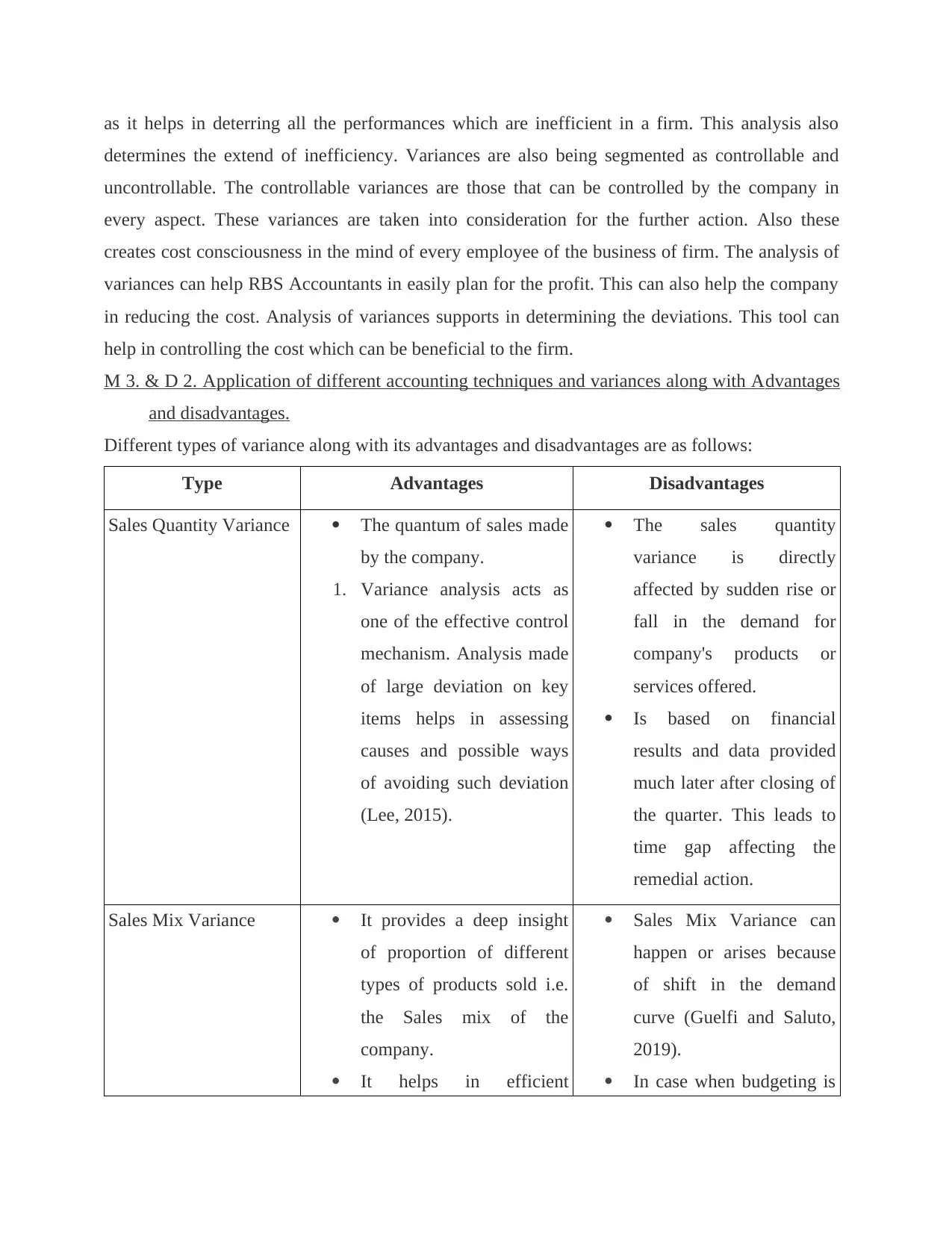
as it helps in deterring all the performances which are inefficient in a firm. This analysis also
determines the extend of inefficiency. Variances are also being segmented as controllable and
uncontrollable. The controllable variances are those that can be controlled by the company in
every aspect. These variances are taken into consideration for the further action. Also these
creates cost consciousness in the mind of every employee of the business of firm. The analysis of
variances can help RBS Accountants in easily plan for the profit. This can also help the company
in reducing the cost. Analysis of variances supports in determining the deviations. This tool can
help in controlling the cost which can be beneficial to the firm.
M 3. & D 2. Application of different accounting techniques and variances along with Advantages
and disadvantages.
Different types of variance along with its advantages and disadvantages are as follows:
Type Advantages Disadvantages
Sales Quantity Variance The quantum of sales made
by the company.
1. Variance analysis acts as
one of the effective control
mechanism. Analysis made
of large deviation on key
items helps in assessing
causes and possible ways
of avoiding such deviation
(Lee, 2015).
The sales quantity
variance is directly
affected by sudden rise or
fall in the demand for
company's products or
services offered.
Is based on financial
results and data provided
much later after closing of
the quarter. This leads to
time gap affecting the
remedial action.
Sales Mix Variance It provides a deep insight
of proportion of different
types of products sold i.e.
the Sales mix of the
company.
It helps in efficient
Sales Mix Variance can
happen or arises because
of shift in the demand
curve (Guelfi and Saluto,
2019).
In case when budgeting is
determines the extend of inefficiency. Variances are also being segmented as controllable and
uncontrollable. The controllable variances are those that can be controlled by the company in
every aspect. These variances are taken into consideration for the further action. Also these
creates cost consciousness in the mind of every employee of the business of firm. The analysis of
variances can help RBS Accountants in easily plan for the profit. This can also help the company
in reducing the cost. Analysis of variances supports in determining the deviations. This tool can
help in controlling the cost which can be beneficial to the firm.
M 3. & D 2. Application of different accounting techniques and variances along with Advantages
and disadvantages.
Different types of variance along with its advantages and disadvantages are as follows:
Type Advantages Disadvantages
Sales Quantity Variance The quantum of sales made
by the company.
1. Variance analysis acts as
one of the effective control
mechanism. Analysis made
of large deviation on key
items helps in assessing
causes and possible ways
of avoiding such deviation
(Lee, 2015).
The sales quantity
variance is directly
affected by sudden rise or
fall in the demand for
company's products or
services offered.
Is based on financial
results and data provided
much later after closing of
the quarter. This leads to
time gap affecting the
remedial action.
Sales Mix Variance It provides a deep insight
of proportion of different
types of products sold i.e.
the Sales mix of the
company.
It helps in efficient
Sales Mix Variance can
happen or arises because
of shift in the demand
curve (Guelfi and Saluto,
2019).
In case when budgeting is
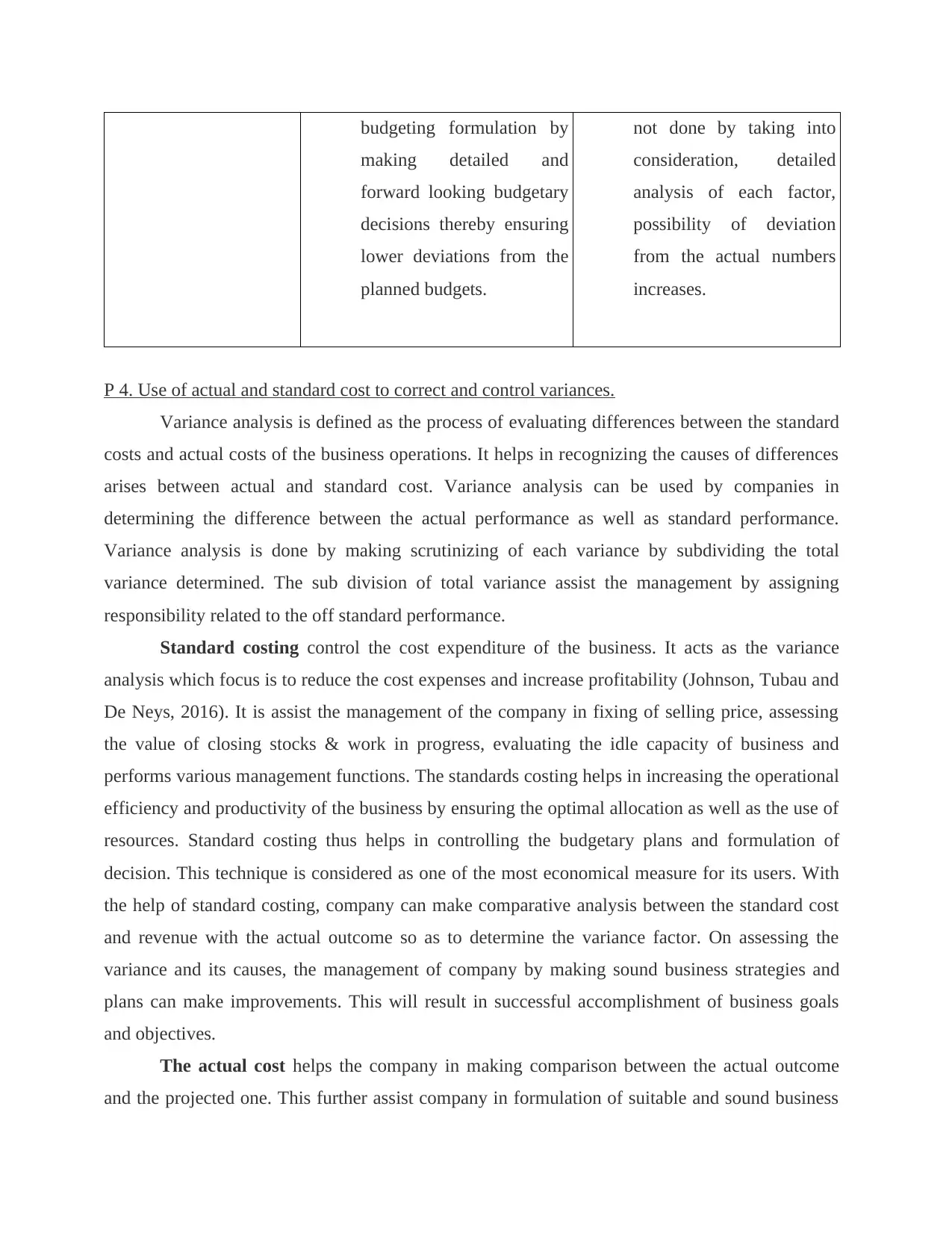
budgeting formulation by
making detailed and
forward looking budgetary
decisions thereby ensuring
lower deviations from the
planned budgets.
not done by taking into
consideration, detailed
analysis of each factor,
possibility of deviation
from the actual numbers
increases.
P 4. Use of actual and standard cost to correct and control variances.
Variance analysis is defined as the process of evaluating differences between the standard
costs and actual costs of the business operations. It helps in recognizing the causes of differences
arises between actual and standard cost. Variance analysis can be used by companies in
determining the difference between the actual performance as well as standard performance.
Variance analysis is done by making scrutinizing of each variance by subdividing the total
variance determined. The sub division of total variance assist the management by assigning
responsibility related to the off standard performance.
Standard costing control the cost expenditure of the business. It acts as the variance
analysis which focus is to reduce the cost expenses and increase profitability (Johnson, Tubau and
De Neys, 2016). It is assist the management of the company in fixing of selling price, assessing
the value of closing stocks & work in progress, evaluating the idle capacity of business and
performs various management functions. The standards costing helps in increasing the operational
efficiency and productivity of the business by ensuring the optimal allocation as well as the use of
resources. Standard costing thus helps in controlling the budgetary plans and formulation of
decision. This technique is considered as one of the most economical measure for its users. With
the help of standard costing, company can make comparative analysis between the standard cost
and revenue with the actual outcome so as to determine the variance factor. On assessing the
variance and its causes, the management of company by making sound business strategies and
plans can make improvements. This will result in successful accomplishment of business goals
and objectives.
The actual cost helps the company in making comparison between the actual outcome
and the projected one. This further assist company in formulation of suitable and sound business
making detailed and
forward looking budgetary
decisions thereby ensuring
lower deviations from the
planned budgets.
not done by taking into
consideration, detailed
analysis of each factor,
possibility of deviation
from the actual numbers
increases.
P 4. Use of actual and standard cost to correct and control variances.
Variance analysis is defined as the process of evaluating differences between the standard
costs and actual costs of the business operations. It helps in recognizing the causes of differences
arises between actual and standard cost. Variance analysis can be used by companies in
determining the difference between the actual performance as well as standard performance.
Variance analysis is done by making scrutinizing of each variance by subdividing the total
variance determined. The sub division of total variance assist the management by assigning
responsibility related to the off standard performance.
Standard costing control the cost expenditure of the business. It acts as the variance
analysis which focus is to reduce the cost expenses and increase profitability (Johnson, Tubau and
De Neys, 2016). It is assist the management of the company in fixing of selling price, assessing
the value of closing stocks & work in progress, evaluating the idle capacity of business and
performs various management functions. The standards costing helps in increasing the operational
efficiency and productivity of the business by ensuring the optimal allocation as well as the use of
resources. Standard costing thus helps in controlling the budgetary plans and formulation of
decision. This technique is considered as one of the most economical measure for its users. With
the help of standard costing, company can make comparative analysis between the standard cost
and revenue with the actual outcome so as to determine the variance factor. On assessing the
variance and its causes, the management of company by making sound business strategies and
plans can make improvements. This will result in successful accomplishment of business goals
and objectives.
The actual cost helps the company in making comparison between the actual outcome
and the projected one. This further assist company in formulation of suitable and sound business
⊘ This is a preview!⊘
Do you want full access?
Subscribe today to unlock all pages.

Trusted by 1+ million students worldwide
1 out of 18
Related Documents
Your All-in-One AI-Powered Toolkit for Academic Success.
+13062052269
info@desklib.com
Available 24*7 on WhatsApp / Email
![[object Object]](/_next/static/media/star-bottom.7253800d.svg)
Unlock your academic potential
Copyright © 2020–2025 A2Z Services. All Rights Reserved. Developed and managed by ZUCOL.





